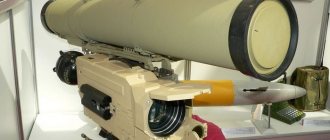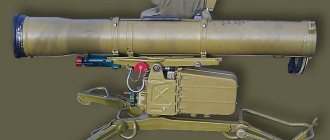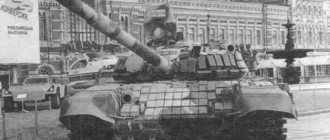Details Category: Tanks and Armored Vehicles Published: 02/13/2017
The Chrysanthemum ATGM is a self-propelled anti-tank missile system designed to destroy tanks and armored vehicles of any type.
- History of creation
- Characteristics
- Radar system
- "Chrysanthemum" rockets
- Chassis
- Operation and prospects
Almost immediately after the appearance of tanks in the world, means of combating them began to be developed. From primitive anti-tank rifles they have evolved to powerful anti-tank missile systems (ATGM). At the moment, ATGMs are of enormous importance in arming the army, so there is a continuous “arms race” in this area. By tradition, Russia is in the lead in it, today with the self-propelled ATGM "Chrysanthemum".
History of creation, what was the impetus for the development
The combat vehicle (BM 9P157) ATGM "Chrysanthemum" was designed at the Kolomna Mechanical Engineering Design Bureau. Previously, variants of the Shmel, Malyutka, and Shturm anti-tank missile systems had already been developed. However, none of the domestic or Western models of ATGMs could detect a target behind a smoke or dust curtain, and therefore could not hit it. The future head of the development of the Chrysanthemum, designer Invincible, had to cope with this task set before him by Marshal of the USSR Ustinov during the Zapad-81 exercises of the Soviet troops. Then it was noticeable that after the artillery barrage, the ATGM battery was unable to open fire due to the dust curtain raised by the explosions. The complex was developed back in the late 80s of the last century, the collapse of the USSR and a change in political course, priorities in production, as well as the economic crisis - all this prevented the timely adoption of the complex for service. Its operation began only in 2005; its first public display was at the parade on May 9, 2014.
Read BTR 82 A - the best in its class
Order to the West
As sources in the Ministry of Defense told Izvestia, Khrizantema-S self-propelled missile systems (ATGMs) are already entering the anti-tank division, which is part of the 2nd Guards Taman Motorized Rifle Division. The new product will replace the less versatile Sturm missile systems.
Izvestia Help
2nd Guards Motorized Rifle Taman Order of the October Revolution, Red Banner, Order of Suvorov Division named after. M.I. Kalinina is part of the 1st Guards Tank Army, which is responsible for the defense of Moscow and the central regions of the country from the western strategic direction. Taman motorized rifle units are deployed in the Moscow region. This division is one of the most powerful strike formations in the western direction, and thanks to the Chrysanthemums, its fire and combat power will increase many times over.
The division is traditionally one of the first to receive the latest complexes and weapons systems in the armed forces. Earlier, the military department reported that Khrizanthem-S, along with the latest MLRS Tornado-G and self-propelled gun Msta-S, began to arrive in formations and military units of the missile forces and artillery. Earlier, Izvestia reported that coastal artillery brigades of the Russian Navy are also receiving these ATGMs.
Now armored vehicles of NATO countries are being assembled in the western strategic direction, military expert Viktor Murakhovsky noted in an interview with Izvestia.
Chrysanthemums in battle_1
Self-propelled anti-tank missile system "Chrysanthemum-S"
Photo: NPO “High-Precision Complexes”
“Just the other day, Great Britain announced that it would send a tank brigade to the continent - to Germany,” he recalled. — This formation is armed with Challenger Mk.3 tanks. Poland purchases German Leopards, modernized specifically for this country, and American Abrams tanks. The United States has repeatedly conducted exercises of its armored units in the Baltic states and Poland. These forces pose a potential threat to the Kaliningrad region and our western borders. In this area, NATO countries have a quantitative superiority in heavy armored vehicles, so strengthening the anti-tank units of the Russian army looks quite logical.
The matter is certain: the Eastern Military District will receive Tornado-S
The Ministry of Defense will re-equip artillery in the Far East with the world's most powerful multiple launch rocket systems
At the moment, Khrysantema-S is the most advanced Russian anti-tank missile system, capable of penetrating the armor of all types of foreign tanks, noted Viktor Murakhovsky.
Universal tactical and technical characteristics of the Chrysanthemum ATGM
BM ATGM "Chrysanthemum" is a unique anti-tank weapon with a crew of 2 people, and is a record holder in the field of armor penetration among all existing and promising ATGMs in the world. The complex can penetrate 1250 mm of armor behind dynamic protection, which allows it to fight any modern tanks at a range of 6 km with 100% efficiency. Three-meter reinforced concrete shelters are also no barrier to a double missile launcher.
The complex also includes auxiliary machines. This is a 9V945 control and inspection vehicle on any wheeled chassis (Ural, KamAZ), as well as a platoon commander and battery commander’s vehicle. The testing machine monitors serviceability and readiness for combat. The vehicles of the platoon commander and battery commander are designed to adjust other complexes and command; the latter is equipped with a PKT machine gun and, in the event of a breakthrough by enemy personnel, can protect the battery.
Anti-tank complex
Modern military equipment in Russia is famous for its survivability, lack of analogues, combat range and superiority over potential opponents. The downside is that new models do not enter service so quickly; the old equipment needs to work out its operating hours.
"Chrysanthemum-S" does not lag behind its comrades and is the most powerful ground anti-tank system in the world. Its high combat range and unpretentiousness to weather conditions make it indispensable. Can participate in both defense and attack. The launcher can be moved without any problems to any heavy-duty base with a carrying capacity of more than 3 tons.
Radars 1L-32 and 1K118 - the reason for the destruction of heavy tanks at a range of up to 6 km
To detect a target behind any type of curtain and at any time of the day, a 1L-32 radar station with waves in the millimeter range is used. There is also a second channel for targeting the target - the 1K118 laser sighting system with television (TV) and thermal imaging (TPV) surveillance. This is how the world's only two-channel ATGM turned out. Using the radar antenna array, targeting the target occurs in automatic mode, after capturing it, the missile is launched within 1 second at a distance of up to 6 km. The operator manually directs the next missile using the laser at the second object at a distance of up to 5 km. The interval of sequential missile launches is 1 second. In total, in 2 seconds you can destroy two heavy tanks of the Abrams and Leopard types.
9M123 Chrysanthemum
The 9M123 missile is supersonic, flying at an average speed of 400 m/s or Mach 1.2 [6] and has a range of 400 to 6,000 meters. [6] Propulsion is achieved by a single solid rocket motor with two exhaust pipes on either side of the rocket. The misaligned exhausts cause the rocket to rotate during flight. Guidance control is provided by two retractable control surfaces at the rear of the missile. Four additional surfaces located directly in front of the controls help stabilize the rocket during flight. The Chrysanthemum is unique among Russian anti-tank guided missiles in that, depending on the missile variant, it can be guided either by laser or by radar. The radar unit uses the millimeter wave range, and the system automatically tracks the target and guides the missile in the radar beam; [8] This form of guidance is LOSBR (line of sight beam movement), that is, ACLOS (automatic line of sight command). In laser targeting, a continuous laser beam is directed towards the target, and a sensor at the rear allows the missile to direct the laser beam towards the target; this form of guidance is LOSBR, that is, SACLOS (semi-automatic command for line of sight). This dual guidance system allows two missiles to be launched simultaneously at two separate targets, with one missile guided by a laser and the other by radar. [3] Each missile carries a tandem shaped charge warhead with a stated armor penetration of 1100–1250 mm RHA (Rolled Homogen Armor) behind the ERA. [9] Alternatively, a thermobaric warhead can be used to engage soft skin targets, fortifications, and manpower. [6]
9P157-2 » Khrizantema-S
» BMP-3 variant
Currently launched from the 9P157-2 Khrizantema-S tank destroyer, the Mi-28 Havoc attack helicopter and, most likely, in the near future also from the Ka-52 Alligator attack helicopter. 9P157-2 Khrizantema-S is based on the BMP-3 chassis. The 9P157-2 carries two 9M123 missiles on launch rails that extend from the stowed position; the radar is also retracted during transport. The tank destroyer automatically reloads missiles from an internal 15-round magazine (missiles are stored and transported in sealed containers), and can also accept ammunition manually loaded from outside the vehicle. [8] The manufacturer states that three 9P157-2 tank destroyers are capable of hitting 14 attacking tanks and destroying at least sixty percent of the attacking force. [8] The dual targeting system provides protection against electronic countermeasures and operation in all climates, day and night. WMD protection is provided for the crew (gunner and driver) of each 9P157-2 in addition to full armor protection equivalent to the standard BMP-3 chassis and trench equipment.
Testing of the modernized version was completed in 2016. The upgraded version was equipped with an IIR/TV sight with a laser rangefinder, a modified radar control system, increased secrecy of the laser beam guidance channel, a set of automated battle control equipment and a more powerful one. Warhead for the 9M123 missile as well. [10]
ATGM 9 M123 for the Chrysanthemum ATGM - capabilities of bicaliber missiles
The Chrysanthemum's ammunition consists of 15 missiles of two types: tandem-cumulative 9M123 and high-explosive 9M123F. The warhead is 8 kg, double, the first warhead penetrates dynamic tank armor, the second the main one. All transport launch containers (TPK) are located inside the body in an automated drum, which significantly increases the rate of fire in combat and brings it to 6 rounds per minute. If a rocket misfires, it is possible to safely reset and load the next one. A mechanical loader arm is provided to reload the drum, which speeds up the process. The missile, 2 m long and 152 mm in diameter, weighs 54 kg, and can accommodate two launchers on a retractable launcher.
Read Tank T-90SM “Breakthrough” - Russian weapon of victory
Rocket characteristics
- Length 2m
- Weight - 54 kg
- Wingspan 0.3 m
- Speed 1450 km/h.
- The maximum speed of the target on the ground is calculated to be up to 60 km/h; air speed up to 340 km/h at an altitude of up to 3 km.
- Maximum launch range - 6000 m
- Maximum armor penetration - 1250 mm
Chassis for the Chrysanthemum ATGM - maneuverability characteristics in combat and on the march
The BMP-3 carries the Chrysanthemum anti-tank missile system - this allows the complex to be used during an offensive; any military transport aircraft can land a 20-ton vehicle in the rear. The entire complex is mounted on a chassis from the BMP-3, thanks to which the crew received bulletproof and anti-fragmentation protection combined with high mobility and maneuverability even in the mountains. Also, “Chrysanthemum” inherited from the BMP-3 the ability to overcome water obstacles without prior preparation at a speed of 10 km/h; water-jet propulsion was installed. All these qualities can be used without fear for the missiles located inside the body; they can easily withstand shaking and sharp maneuvers. Combat vehicles reach their maximum speed of up to 50 km/h over rough terrain and in mud and snow. The power plant of the BMP-3 was the UDT-29 500 hp engine. Power reserve 600 km.
Operation and prospects
Currently, Russia is undergoing a partial replacement of outdated systems with new Chrysanthemum anti-tank systems; 10 units of equipment have been adopted. The process is moving rather slowly, because the systems in service are still effective and have not exhausted their service life. 10 complexes were delivered under an agreement to Azerbaijan, 14 were sent to Libya between 2010 and 2013. Judging by the approving gestures in the photographs with the participation of the Chrysanthemum, one can understand the soldiers who are absolutely satisfied with the work of these complexes.
Combining all the above qualities, it is worth noting that the designers created the best machine in its class. The combination of powerful armor penetration and unsurpassed visibility is the advantage of the Chrysanthemum, which can be confidently fought alone against five tanks. The designers claim that three complexes are capable of stopping an attack by a tank company consisting of 14 tanks. Moreover, 60% of attackers are guaranteed to be destroyed in the first seconds of their detection.
Read BRDM-3 - reconnaissance and patrol armored personnel carrier of the Russian Federation
Such results can also be achieved in an unexpected collision with the enemy; the complex goes into combat position in just 20 seconds. The Chrysanthemum anti-ship missile system can destroy not only tanks and armored vehicles, but also low-flying aircraft and helicopters, small ships, as well as destroy engineering and fortification structures. These parameters make it a universal weapon. Due to its stealth nature, the Chrysanthemum can be successfully used for defensive purposes, and its high maneuverability and mobility make it a suitable offensive support weapon.











